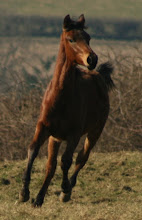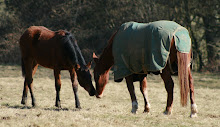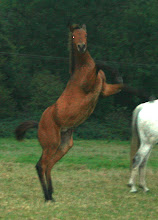There have been no significant changes with Penny over the last few days. Her udder continues to develop with wax appearing now and then. Her field companion, Lilly, has changed shape however. Lilly has 10 days to go and is definatley slowing down rather. Her udder is pretty under developed though, in comparison with Penny's.
On the advice of my vet and others, I have ordered some calcium strips. These will help determine when Penny will foal, hopefully saving me many sleepless nights. They are able to predict when a mare will foal within 24 hrs, in which case I would keep her in and take the day off work.
This is a bit about how they work:
Changes in mammary secretion electrolytes most commonly occurs at night, coincident with the period when the majority of mares foal. Stall-side tests are available to measure calcium (Ca++) or calcium carbonate (CaCO3) concentration. Test kits measuring mammary secretion Ca++ typically employ a colorimetric change of pads on a test strip from green to red (Predict-A-Foal tm) or titration of a diluted sample until an indicator dye changes from pink to blue (Titret tm). The dilution kits are somewhat more labor intensive than the test strip kits. Of the commercially available mammary secretion test kits, Ley [12] found the Titrettm test kit to be the most reliable and repeatable test for predicting foaling within 24 hours. Using this kit, mares with mammary secretion CaCO3 > 200 ppm had a 54% probability of foaling within 24 hours, 84% probability of foaling within 48 hours and 97% probability of foaling within 72 hours. Most mares foaled within a short period of time if the mammary secretion CaCO3 was between 300 and 500 ppm. Mares with mammary secretion CaCO3 <>
Lilly appears to have developed a kind of blood blister near where her belly button would be. I haven't seen this in an adult horse before though hernia's in that area are common in foals. A friend of Kim's assures her that it is nothing to worry about but to do with her milk production. I'm a bit sceptical about that theory as I have seen probably about 200 pregnant mares and never seen that! Her mammary glands are further back than the site of this lump. I think it more likely to be as a result of a kick or something. It doesn't seem to be bothering her though so I think Kim is going to leave it for a while and see what happens.
Monday, 28 May 2007
Subscribe to:
Post Comments (Atom)






















































No comments:
Post a Comment